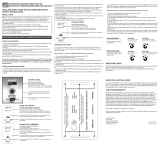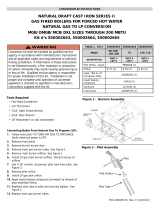
I-RP-HRPD (04-21) 132210-A, Page 2
WARNING
Improper installation, adjustment, alteration, service, or maintenance can cause property
damage, injury or death. Read the installation, operation, and maintenance instructions
thoroughly before installing or servicing this equipment.
WARNING
To ensure safety, follow lighting instructions located on the outlet box cover. See Hazard
Levels, above.
Denitions of HAZARD INTENSITY LEVELS used in this Manual
1. DANGER: Failure to comply will result in severe personal injury or death and/or property
damage.
2. WARNING: Failure to comply could result in severe personal injury or death and/or property
damage.
3. CAUTION: Failure to comply could result in minor personal injury and/or property damage.
WARNING
Gas-red appliances are not designed for use in hazardous atmospheres containing
ammable vapors or combustible dust, in atmospheres containing chlorinated or
halogenated hydrocarbons, or in applications with airborne silicone substances. See
Hazard Levels, above.
1.1 Hazard Labels and Notices
There are warning labels on the unit and throughout this manual. For your safety, read
the denitions below and comply with all boxes labeled CAUTION, WARNING, and
DANGER during installation, operation, maintenance, and service of this heater.
1.0 General
1.0 General .............................................................. 2
1.1 Hazard Labels and Notices.......................2
1.2 General Installation Information ..............3
1.3 Warranty .....................................................3
1.4 Installation Codes .....................................3
2.0 Furnace Location ............................................. 3
2.1 General Recommendations ......................3
2.2 Combustion Air Requirements ................3
3.0 Uncrating and Preparation .............................. 4
3.1 Uncrating and Inspecting .........................4
3.2 Preparing the Furnace for Installation ....4
4.0 Dimensions and Clearances ........................... 5
4.1 Dimensions ................................................5
4.2 Clearances .................................................6
5.0 Mounting ........................................................... 6
6.0 Mechanical ........................................................ 7
6.1 Gas Piping and Pressures ........................7
6.2 High Elevation (>2,000 Feet/609 Meters)
Installations ...............................................9
6.3 Conversion to LP (Propane) ...................10
6.4 Venting ....................................................11
6.5 Duct Furnace Airow ..............................12
7.0 Electrical Supply and Connections .............. 15
7.1 General .....................................................15
7.2 Supply Voltage and Wiring .....................15
7.3 Thermostat and Control Wiring .............16
7.4 Wiring Diagrams ......................................17
8.0 Controls .......................................................... 17
8.1 Fan Control .............................................17
8.2 Limit Switch .............................................17
8.3 Combustion Air Proving Switch ............18
8.4 Gas Controls ............................................18
8.5 Pilot and Ignition Systems .....................23
8.6 Burners and Carryover System .............24
8.7 Burner Air Adjustment ............................24
9.0 Commissioning and Startup ......................... 25
9.1 Check the installation prior to startup: .25
9.2 Startup .....................................................25
9.3 Check Installation After Startup .............25
10.0 Maintenance and Service ............................ 26
10.1 Maintenance Schedule..........................26
10.2 Maintenance Procedures ......................26
10.3 Troubleshooting ....................................29
APPENDIX ............................................................. 30
Converting Model RP Duct Furnace for
Lower Temperature Rise and igher CFM
Application ....................................................30
INSTALLATION RECORD .................................... 32
Table of Contents






















